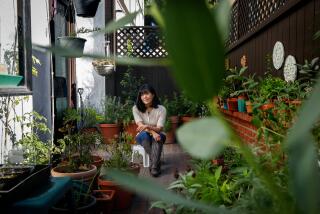GARDENING : Containers Hold Lots of Pluses for Plantings
- Share via
Containers often make it easier to cope with gardening problems such as weather, marginal soil, lack of space, weeds, pests, watering or too little or too much sun.
They are a major plus, too, when it becomes difficult to work at ground level.
Vegetables and containers seem made for each other. Although many flowers and shrubs also do well in them, containers really shine in producing vegetables. And the ornamental appearance of many vegetables is another advantage.
Just about any vegetable--even sweet corn and potatoes--will produce a crop in a container. But fast growers usually are best. Most satisfactory are those that develop fruit over a long period of time, such as tomatoes, eggplant and peppers, or are harvested by picking outer leaves, such as leaf lettuce and herbs. They continue to grow and produce as you harvest.
With temperature-sensitive plants, containers can be rolled outdoors on warm, sunny days and back indoors at night.
Certain basics must always be followed:
* Probably the most important: Varieties must be suitable to your climate and the time of year during which you plan to grow them.
* Next, buy or make an artificial soil mix. Regular garden soil, regardless of how good it is, will not work well in containers.
* Never forget that vegetables need to be in a state of growth for best quality. This means close attention to watering and fertilizing.
* And remember that although vegetables prefer at least six hours of daily sunshine, most dislike heat--and containers in full sun can get quite hot, cooking the roots. Avoid western exposures and windy places.
Just about any type of container will work. If it can hold sufficient growing material and its appearance pleases you, the plants should be happy. Be sure there are drain holes.
The five-gallon containers that nursery plants come in are a good starting point. Three-gallon size usually is minimum.
Many gardeners like the wooden half-barrels because they are large enough to hold several plants and retain a good moisture reserve.
Potatoes do fine in them. Leaf lettuce, peppers, green onions, shallots, garlic, herbs, tomatoes and carrots are excellent. Use dwarf varieties when available.
One caution: Before filling the containers with soil mix, place them where you want them. Otherwise, they may be too heavy to move. The mix must drain well and remain light and open. With only a few containers, it’s simpler to buy a commercial mix.
Homemade is cheaper, and you can be sure of what’s in it. A good proportion is equal parts of coarse sand, peat moss, vermiculite and perlite. This encourages strong roots. Before mixing, add horticulture lime and soil sulfur or gypsum.
Leave an inch or two of top space that can be filled with water at each watering.
Another plus with a soilless mix is that insects, diseases and weeds often are nonexistent.
For fertilizer, slow-release types work well. Many gardeners prefer applying a nutrient-balanced solution when watering. But remember that while leafy vegetables require heavy fertilization, fruiting vegetables grow a lot of foliage and produce poorly if given excess nitrogen.
Use the manufacturer’s recommendation as a starting point, and observe carefully before adjusting.
If light comes only from one side, revolve the container a quarter turn each week, if this is possible. Black containers, by attracting sun in a sunny location, provide an early jump on summer. But be careful of this later in the year.
Determining watering needs can be difficult. Moisture meters are inexpensive. Another option: Stick a finger into the growing medium up to the first knuckle. If the finger feels moist when removed, try again the next day.






